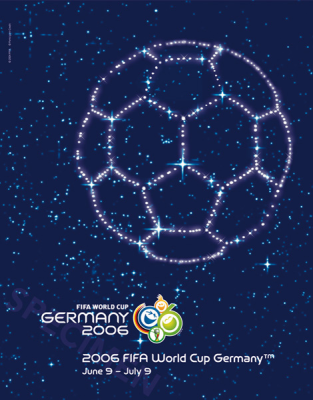 Our series on the US at the World Cup continues with a look at the 2006 World Cup in Germany.
Our series on the US at the World Cup continues with a look at the 2006 World Cup in Germany.
While the US enjoyed its best finish at the inaugural World Cup in 1930 where it finished third, it is safe to say the team’s best World Cup performance was in 2002. Finishing third in 1930 was a major accomplishment that had surprised many observers. But, only four European teams made the trip to Uruguay and no African or Asian countries were represented. Simply put, in 1930 the tournament was a “World Cup” more in name than actual fact.
In 2002, the US again surprised many observers by making it to the quarterfinals and the team’s performance in the quarterfinal match left many observers thinking that the US had actually outplayed the winner of that game, and eventual tournament finalist, Germany. After a dismal performance in 1998 where it finished 32nd out of 32 teams, the US had shown it deserved to be on the world stage.
While the third place finish in 1930 came at a time when the American Soccer League could legitimately claim to be the second most popular professional team sport in the US, the economy of professional sports was barely developed. Professional soccer would experience years of decline before the NASL’s all too brief brief and entirely unstable appearance. Its reliance on aging foreign players to sell tickets meant that the league’s contribution to the development of talent for the national team was marginal at best.
With the appearance of Major League Soccer in 1996 — the origin of which was tied to the US winning the bid to host the 1994 World Cup — the US now had a pool of players who either had their beginnings in, or were currently playing in, a stable professional American soccer league, even if it was one that continued to struggle to find its place in a professional sports economy that had long before been staked out by American football, baseball, basketball, and hockey.
The US campaign in 2002 had gone some way in helping to shore up MLS as fans of the national team both new and old looked for ways to continue to follow the game. Importantly, the US performance had raised the expectations of those fans as well as more casual observers. Simply making it to the World Cup was no longer a measure of success. By the time of its fifth consecutive World Cup appearance in Germany in 2006 US soccer fans now expected the team to advance from the group stage.
Qualifying for the 2006 World Cup
Some 34 countries participated in the preliminary round of CONCACAF qualifiers, with ten groups of three teams and two groups of two teams. The best ranked team in each of the first ten groups of three was given a bye. At least ten teams — three of which were coached by former US national team coaches — in the first round would use players from MLS, an indication of the league’s growing regional importance. Coaching the US team was Bruce Arena, who had guided the team through the 2002 tournament. It would be the first — and so far, only — time the team would have the same head coach for two consecutive World Cups.
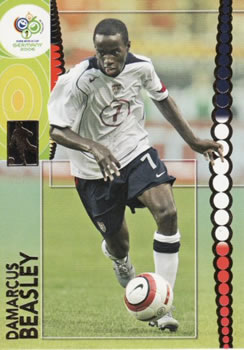 Ten teams had been eliminated when the US entered the second round of qualification to face Grenada, who had defeated Guyana by a total score of 8–1 in its first two games. At Columbus Crew Stadium on June 13, 2004, the US was the comfortable 3-0 winner, with DaMarcus Beasley scoring a brace (45′, 71′) before Greg Vanney added another goal in the 90th minute. When the teams met at Grenada National Stadium on June 20, the match was tighter. Jason Roberts (12′) and Ricky Charles (77′) scored for Grenada but the US was never behind in the match with goals from Landon Donovan (6′), Josh Wolff (19′), and Beasley (76′) in the 3-2 win.
Ten teams had been eliminated when the US entered the second round of qualification to face Grenada, who had defeated Guyana by a total score of 8–1 in its first two games. At Columbus Crew Stadium on June 13, 2004, the US was the comfortable 3-0 winner, with DaMarcus Beasley scoring a brace (45′, 71′) before Greg Vanney added another goal in the 90th minute. When the teams met at Grenada National Stadium on June 20, the match was tighter. Jason Roberts (12′) and Ricky Charles (77′) scored for Grenada but the US was never behind in the match with goals from Landon Donovan (6′), Josh Wolff (19′), and Beasley (76′) in the 3-2 win.
With the qualification field now down to 12 teams, the US was drawn into Group 1 along with Panama, Jamaica, and El Salvador. They began against Jamaica away at Independence Park on August 18 in front of wildly enthusiastic home support. The home team came out to attack but the US was able to stop any threats until Ian Goodison scored in the 49th minute. Brian Ching, playing in his third international, salvaged the 1-1 tie when he shot home a pass from Donovan in the 88th minute.
Hosting El Salvador at Gillette Stadium on September 4, the US dominated the match, outshooting their opponents 19–1 for a 2–0 win from goals by Ching (5′) and Donovan (68′). Playing Panama four days later on September 8 at Estadio Rommel Fernandez, the US put in one of their worst performances in years, though Roberto Brown’s goal in the 69th minute was equaled by Cobi Jones in stoppage time from what appeared to be an offsides position for another 1-1 road draw.
The US coasted its way through the rest of the third round of qualifiers. At Estadio Cuscatlan in El Salvador on October 9, Brian McBride scored the first goal in the 2–0 victory in the 29th minute. Eddie Johnson, making his international debut, scored the second in the 75th minute, just five minutes after coming on as a sub. Four days later the US demolished Panama 6–1 on October 13 at RFK Stadium. Donovan’s two goals performance was bested by Johnson’s hat trick (69, 84′, 86′), this time after being subbed into the game in the 65th minute. Panama contributed to the US tally with an own goal by Jose Anthony Torres in the 89th minute.
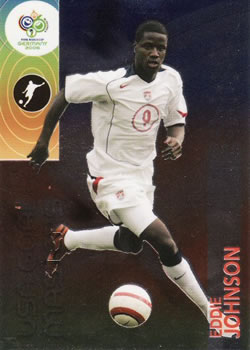 Having secured its advancement to the final round of qualification, the last match against Jamaica at Columbus Crew Stadium on November 17 was notable primarily for Johnson becoming the first US player to score in his first three qualification games, scoring his fifth goal (15′) after a total of only 61 minutes on the pitch as an international. Jamaica’s Andrew Williams scored in the 26th minute for a 1–1 draw.
Having secured its advancement to the final round of qualification, the last match against Jamaica at Columbus Crew Stadium on November 17 was notable primarily for Johnson becoming the first US player to score in his first three qualification games, scoring his fifth goal (15′) after a total of only 61 minutes on the pitch as an international. Jamaica’s Andrew Williams scored in the 26th minute for a 1–1 draw.
In the final stage of qualification, the US was joined by Mexico, Costa Rica, Trinidad & Tobago, Guatemala, and Panama. At first the US team was overshadowed by events off the field: the US players were involved in a contract dispute with the the United States Soccer Federation over player compensation, retroactivity, and World Cup bonuses that resulted in the cancellation of the January 2005 training camp. Thankfully, the players agreed to put aside the dispute until after the qualifiers were completed.
The US renewed its campaign with a 2–1 victory over Trinidad & Tobago on February 9, 2005 at Queen’s Park Oval in Port-of-Spain, with Johnson (23′) scoring again. Eddie Lewis scored in the 53rd minute before Angus Eve got a consolation goal for the home team in the 87th minute.
Lewis 58th minute tally was the lone US goal in the 2–1 loss to Mexico at the Azteca on March 27. Having packed the midfield with five players, the US held off Mexico for the first 30 minutes before Jared Borgetti scored for the home team. Two minutes later, Zinha scored again for Mexico. The US rebounded three days later with a 2–0 victory over Guatemala at Legion field in Birmingham, Alabama, on March 30 with goals by Johnson (11′) and Steve Ralston (69′).
The US next hosted Costa Rica on June 4 at Rice Eccles Stadium in Salt Lake City. Two goals by Donovan (10′, 62′) and another by McBride (87′) gave the US a 3–0 win. Four days later, the US beat Panama 3–0 on June 8 at Estadio Rommel Fernández in Panama City with goals from Carlos Bocanegra (6′), Donovan (19′) and McBride (39′). Taking time off to win the 2005 Gold Cup over Panama on penalty kicks, the team resumed its qualification campaign with a 1–0 victory over Trinidad & Tobago on August 17 at Rentschler Field in East Hartford, Connecticut, thanks to a McBride goal in the 2nd minute.
With four games remaining, the US now needed only one more victory to qualify for the 2006 World Cup. Fittingly, their next opponent was Mexico. After a scoreless first half at Columbus Crew Stadium on September 3, 2005, the US took the lead with a goal from Ralston in the 53rd minute. Four minutes later, Claudio Reyna delivered the ball to Beasley who finished to make it 2–0, the final scoreline of the match.
Unimaginable only a few years before, the US had qualified for the World Cup with three matches to go. A 0–0 draw against Guatemala at Estadio Mateo Flores on September 7 was followed by a disappointing 3–0 loss to Costa Rica at Estadio Ricardo Saprissa on October 8 with a single goal by Paulo Wanchope (34′) and two from Carlos Hernandez (60′, 88′). But the US rebounded with a convincing 2–0 victory over Panama four days later at Gillette Stadium thanks to goals from Kyle Martino (51′) and Taylor Twellman (57′) on October 12. (Philadelphia Union fans might be interested to know that, in addition to goals from future Union broadcasters Martino and Twellman, future Union players Danny Califf, Chris Albright, Brian Carroll, and Justin Mapp also started in the win. Califf, Albright, and Carroll all went the full 90 while Mapp was subbed out in the 58th minute, Martino in the 68th minute, and Twellman in the 74th minute. The Union connections don’t end there: Going the full 90 for Panama was Gabriel Gomez. The soccer world can be a small place.)
At the 2006 World Cup
Head coach Bruce Arena had used 46 players in the qualifiers for the 2006 World Cup. When the final 23-player roster was announced, eleven players returned from the 2002 World Cup squad. For core players Kasey Keller and Reyna, 2006 would be their fourth World Cup, the third for McBride and Eddie Pope. Young phenoms at the 2002 World Cup like Donovan, Beasley, Wolff, and Pablo Mastroeni were joined by rising talents like Philadelphia’s own Bobby Convey as well as Clint Dempsey, Oguchi Oneywu, and Johnson. (Philadelphia-born Chris Albright and Harrisburg-born Ben Olsen were also on the squad. While Albright made no appearances, Olsen was a 40th minute substitute in the game against Ghana.) Of the 23 players who made the trip to Germany, 18 would see minutes in the tournament.
The performance of the US team at the 2002 World Cup, combined with its dominance in the CONCACAF qualifications for the 2006 World Cup and being ranked fifth in the world going into the tournament, meant high expectations within the US team and for its fans. But the US had been drawn into Group E with the No. 2 ranked Czech Republic, No. 13 ranked Italy, and Ghana who, despite being ranked 48th, were recognized as being a formidable force.
It was the Group of Death.
USA 0–3 Czech Republic
When the US played Czechoslovakia in its first World Cup match in 40 years in the 1990 tournament, it took 25 minutes for the Czechs to score in what became a 5–1 rout. On June 12, 2006, at Veltins-Arena in Gelsenkirchen, reality came to the US five minutes after the opening whistle off of the head of Jan Koller. By the time Tomas Rosicky was finished adding two more goals in the 36th and 76th minutes the US was in a state of shock. Looking like what the Associated Press described as a “bewildered World Cup newcomer again,” the US managed only one shot on goal during the game. Its showing at the previous World Cup meant that the US was taken very seriously by the Czech team and they “swarmed” Donovan and Beasley, the surprise sensations of 2002.
Coach Bruce Arena, before now not known as one to publicly criticize his players, said, ”Landon showed no aggressiveness tonight…We got nothing out of Beasley on the night.” Convey was singled out as one of the few US players who had ”the courage” to attack. Said Keller after the game, ”We didn’t play well. We didn’t compete. We didn’t make the plays…It was just a shame. We definitely gave the game away, and that’s what we’re frustrated about.”
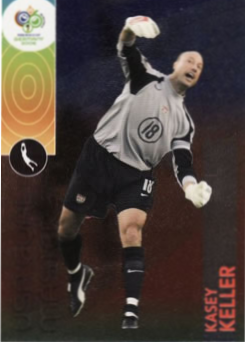 With their next match against Italy only five days away, Reyna warned, ”We all have to learn quick, especially the young guys…We can’t wait months or years to get better. We have to get better quickly, and I think we can do that.” In actuality, the US’ chances were very slim: in the previous two World Cups, only one team, Turkey, had lost its first match and managed to advance out of the group stage.
With their next match against Italy only five days away, Reyna warned, ”We all have to learn quick, especially the young guys…We can’t wait months or years to get better. We have to get better quickly, and I think we can do that.” In actuality, the US’ chances were very slim: in the previous two World Cups, only one team, Turkey, had lost its first match and managed to advance out of the group stage.
USA 1–1 Italy
In a game that featured a lot of red in the form of blood, it was red cards that were the deciding factor in this hard fought match on June 17 at Fritz-Walter-Stadion in Kaiserslautern.
The US knew it needed a win if it was to have any control over its own destiny and the team made its intentions clear to the Italians from the start. But in the 22nd minute the team’s difficulties in defending set pieces showed when Alberto Gilardino got behind the US defense to head home Andrea Pirlo’s free kick. Five minutes later the US got lucky when Convey’s free kick was deflected into the net by Cristian Zaccardo.
And then the Uruguayan referee Jorge Larrionda began, in the words of the Associated Press report on the game, “flashing red cards at a pace seldom seen in World Cup play,” sending off Daniele De Rossi in the 28th minute for a nasty challenge to McBride that required three stitches to his left cheek. In the 45th minute, Mastroeni was sent off for a cleats-up challenge to Pirlo. Mastroeni said afterward, ”I think that foul anywhere in the world is a yellow card.” Two minutes into the second half Pope was sent off after receiving a second yellow card for a tackle in which he first won the ball and then took down Gilardino. The rest of the match would be played nine on ten.
Still, the US continued to attack and in the 66th minute Beasley appeared to score the go ahead goal only to have it called back for offsides. The US was kept in the game largely because of a Man of the Match performance from Keller that included him making two terrific saves on dangerous shots by Alessandro Del Piero. Said Keller after the match, “It was a crazy game.”
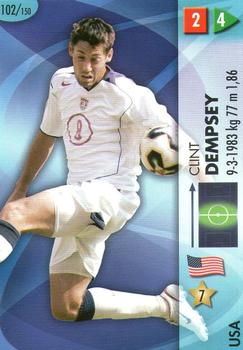 The draw gave the US its first point in any World Cup match in Europe. While this may have been an small consolation, greater consolation was provided by the upset victory by Ghana over the Czech Republic: the point meant that the US could advance if they defeated Ghana and Italy also beat the Czechs.
The draw gave the US its first point in any World Cup match in Europe. While this may have been an small consolation, greater consolation was provided by the upset victory by Ghana over the Czech Republic: the point meant that the US could advance if they defeated Ghana and Italy also beat the Czechs.
USA 1–2 Ghana
The US faced Ghana in a do-or-die match on June 22 at EasyCredit-Stadion in Nuremberg. When Haminu Draman put Ghana up 1–0 in the 22nd minute the US did not wilt and in the 43rd minute Clint Dempsey equalized with a volley from a cross by Beasley. Only four minutes later, in the second minute of first half stoppage time, the game turned on a hotly disputed call by German referee Markus Merk. Jostling for a header on the edge of the penalty area, the 6-foot-4 Onyewu made contact with the 5-foot-8 Razak Pimpong. Merk pointed to the penalty spot and Steven Appiah converted to put Ghana up 2–1.
Dempsey said of the penalty call, “Takes the wind out of your sails. We thought going into halftime we were tied up. That wasn’t the case.”
The team’s best chance to equalize in the second half was a diving header by the fearless McBride in the 66th minute that banged off of the post. But the US simply could not find the net. Despite Italy’s 2–0 victory over the Czech Republic, the US was out of the World Cup.
Said Donovan after the match, “The worst part is the finality of it…Even during the game, you don’t get the sense, ‘This is it.’ The whistle blows and it’s over.”
Ghana would lose 3–0 to Brazil in the Round of 16. Italy would beat Australia 1–0 off of a controversial penalty during stoppage time. In the quarterfinals Italy would defeat Ukraine 3–0. Against Germany in the semifinals Italy won with two goals after extra time. On July 9, 2006, Italy would face France in the final at the Olympiastadion in Berlin. Zinadine Zidane’s masterful Man of the Match performance in France’s 1-0 win over Brazil in the quarterfinals had been followed by his penalty kick goal in the 1-0 win over Portugal in the semifinals.
In the final, Zidane opened the scoring with another penalty kick goal in the seventh minute before Marco Materazzi equalized for Italy only 12 minutes later from a Pirlo cornerkick. The game remained tied at 1-1 after regulation time. In the 110th minute, one of the most notorious incidents in World Cup history saw Zidane ejected from the game in the 110th minute after he headbutted Materazzi in the chest. In the end, Italy would win the 2006 World Cup on penalty kicks.
As they had done in 1998, the US finished dead last in the tournament. The team managed only four shots on goal during group play, the lowest tally of any team at the 2006 World Cup. Three weeks after the tournament, Arena was dismissed with Bob Bradley taking over as interim coach. By the end of the year, the US had dropped to 31st in the FIFA rankings. Ghana was ranked 28th.
In May of 2007, Bradley was named head coach. Qualification for the the 2010 World Cup would begin for the US little more than a year later.
June 12, 2006: USA v Czech Republic (complete game, Part 1)
June 12, 2006: USA v Czech Republic (complete game, Part 2)
June 17, 2006: USA v Italy (complete game)
June 22, 2006: USA v Ghana (complete game, Part 1)
June 22, 2006: USA v Ghana (complete game, Part 2)
A version of this article was originally published on June 10, 2010
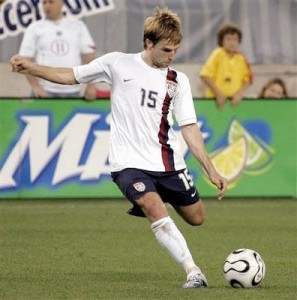
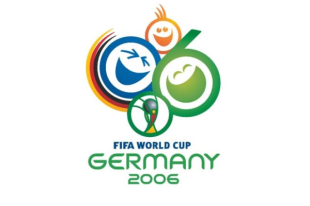

Bravo! great work on this series
Thanks for reading!
Despite our frankly rancid performance at this tournament, the 2006 World Cup holds a special place in my heart because this was the year, and the summer in particular, where soccer really “clicked” for me and I became hopelessly addicted.
.
I also recall that year casually mentioning to the author of this post my newfound love for this game while he was bartending at the 700 on a Thursday night. The feeling, as it turned out, was mutual :). Thanks for the trip down memory lane, Ed, see you tomorrow!
Damn you Ghana!!!!!! I hope we’re not saying that again this summer!
My wife and I had just moved back to Philadelphia from Portland, Oregon in 2006 and we were having work done on our kitchen. Two polish men showed up at our home to work that morning, June 14 with only one request, ‘Could we turn on the Poland Germany game while he worked.’ ‘Sure.’ Watched the whole game with them and it was tense.
.
I remember being hopeful about team USA but having no real expectations in how they played. This was a time before I became completely transfixed by the ebb and flow of the beautiful game. I knew the US were outside the mean when it came to world quality.
.
I played as a youth but quit the game to focus on golf and only follow the game when world cup came around. I remember the utter tension and despondency of the two workers after a tough 1-nil defeat to eventual group winner Germany. Poland had lost 2-0 to Ecuador in round 1 and knew they needed at least a draw to stay alive. The men didn’t say a word once the game was over. Crestfallen. This is the world’s game.
Great story, Fee, thank you for sharing it.
Anyone know how I can watch the full game replays of all these games? I like to watch old replays of games to study them and learn.